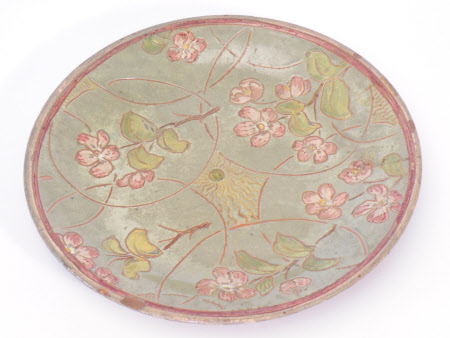Plaque
Della Robbia Pottery
Category
Ceramics
Date
1895 - 1899
Materials
red earthenware with coloured slips and sgraffito
Measurements
28 mm (H)210 mm (Diameter)
Place of origin
Birkenhead
Order this imageCollection
Standen House and Garden, West Sussex
NT 1213671.1
Summary
Plaque, red earthenware with slip, circular form without a central well, flattened foot rim wiped clean of slip, designed and decorated by Aphra Peirce, Della Robbia Pottery, Birkenhead, 1895-9; decorated with overlapping incised circles and naturalistic branches of pink blossom against a pale blue ground, red band at rim.
Full description
Aphra Peirce (b.1870) grew up in County Limerick. Aphra and her sister, Lena, moved to Merseyside to work at the short-lived Della Robbia Pottery in Birkenhead, which operated from 1894-1906. Aphra often both designed and decorated her pieces and was described as ‘a designer of striking originality’ in an 1897 article in The Magazine of Art. Her work is distinctive among the Della Robbia potters. The two plaques by her at Standen, painted in muted colours not typical of the factory, are good examples of her recognisable style. After leaving Della Robbia, Peirce continued her career at the Doulton factory in Stoke-on-Trent. Taking its name and inspiration from the maiolica (tin glazed earthenware) masterpieces of Italian Renaissance sculptor Luca Della Robbia, the studio was established according to Arts and Crafts principles, aspiring to use local labour and materials, and to create works entirely by hand. Della Robbia employed many women as designers and decorators and Walker’s work is among its very finest and most progressive. The ceramics were bold, bright and colourful – the Magazine of Art reported that, with Della Robbia ceramics in a room, ‘the ordinary meal would have the comparative air of a banquet.’ Unfortunately, the venture was never profitable and it closed after just 12 years in business. Harold Rathbone was the founder of and driving force behind the Della Robbia Pottery. He trained at the Slade School of Art and then at the Académie Julian in Paris. In 1878, he visited Italy with his family, where encountered the work of fifteenth century ceramicist and sculptor, Luca Della Robbia. Rathbone based himself in London and exhibited work widely. Rathbone’s father was a prolific patron of the arts and the family was well known in Pre-Raphaelite circles. By the time he established the Della Robbia Pottery, Rathbone was connected to many distinguished artists and thinkers, including John Ruskin, Mary Seton Watts and George Frederic Watts, Ford Maddox Brown and Frank Brangwyn.
Marks and inscriptions
Underside of base: D [ship] R (incised, maker's mark) AP (incised, for Aphra Peirce)
Makers and roles
Della Robbia Pottery , manufacturer Aphra Peirce, designer
References
Hyland 2013: Peter Hyland, The Della Robbia Pottery, Birkenhead, 1894-1906, Suffolk: Antique Collectors’ Club 2013

